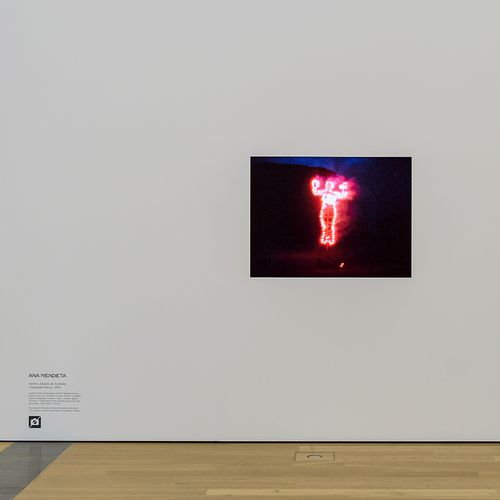AUDIO
Ana Mendieta
Ana Mendieta worked with her body—and with nature. She usually staged her performances alone, outdoors, in remote landscapes. Photographs and videos provide the only lasting evidence. No stage, no audience. Only traces. Mendieta left outlines of her body in earth, sand, or stone. Sometimes she outlined the contours with flowers or fire. These pieces become a type of ritual, an attempt to connect with the earth. For Mendieta, this represented her personal experience. She and her sister grew up in exile, having been sent from Cuba to the United States as children.
In the 1976 video piece Anima, Silueta de Cohetes, fireworks trace the silhouette of a female figure. The figure blazes up—and disappears again as the fireworks die down. No body remains, no message, only an afterimage.
The black-and-white photograph Maroya from 1981 also depicts the female body only indirectly, as an impression in a rock formation—with an exaggerated vulva. The title references a Caribbean moon goddess. At the same time, the form evokes prehistoric depictions of female figures, such as the Venus of Willendorf, or medieval figures like the sheela-na-gig. Mendieta does not simply reproduce these images. She changes them—and leaves many questions unanswered.
Her art thus stands in stark counterpoint to two movements of her time: feminist art, which demanded visibility, and Land Art, which often treated nature as a neutral space for manipulation. Mendieta, by contrast, worked with absence, vulnerability, and dissolution.
Only traces remain. And the question of how we can inscribe memory, body, and origin into a landscape.
In the 1976 video piece Anima, Silueta de Cohetes, fireworks trace the silhouette of a female figure. The figure blazes up—and disappears again as the fireworks die down. No body remains, no message, only an afterimage.
The black-and-white photograph Maroya from 1981 also depicts the female body only indirectly, as an impression in a rock formation—with an exaggerated vulva. The title references a Caribbean moon goddess. At the same time, the form evokes prehistoric depictions of female figures, such as the Venus of Willendorf, or medieval figures like the sheela-na-gig. Mendieta does not simply reproduce these images. She changes them—and leaves many questions unanswered.
Her art thus stands in stark counterpoint to two movements of her time: feminist art, which demanded visibility, and Land Art, which often treated nature as a neutral space for manipulation. Mendieta, by contrast, worked with absence, vulnerability, and dissolution.
Only traces remain. And the question of how we can inscribe memory, body, and origin into a landscape.
